We are back on the ice, still far from our target location. Sailing is slow even though the ice is not very thick. Alex said it is 1st year ice with lots of snow, which produces a lot of the friction with the boat and slows it down. We have had to stop, back a bit, and then charge forward again. This is called ramming. I am not sure how much ramming we can do before turning back. The ice maps suggest there might be thinner ice ahead. Jim said we will see how far we get by breakfast, since we are running out of time.
First year ice, said Alex, what does he mean? This is a perfect time to talk about different types of ice. Perhaps you have heard that inuits have lots of words for naming snow. I have found people on board have quite a few words for naming ice according to its developmental stage. I will describe the basic terminology. I wish I could have gone out and place an object of known size so you would have a size reference. Let us take a look at some of these names:
The first stages of ice formation are the same as in a lake, so if you live in an area with cold winters near a like you might have seen these stages. Things get more interesting later as the waves modify the ice.
Frazil Frazil is the presence of ice crystals in the shape of fine needles or small flakes suspended in a somewhat thick layer of water.
I saw the second stage of ice formation for the first time at McMurdo Station on a very calm night. I looked out through the window of the library down to the bay and saw what appeared to be a thin skin on the water, undulating with the waves. I went down to see it more closely and found,
Grease ice Grease ice is a thin layer on the surface of the water that looks like oil or soap. The picture below shows grease ice in small patches separated by the wind. I took this picture from the bridge of the Palmer as we left McMurdo.
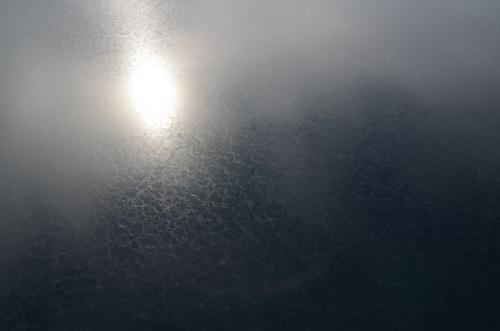
Nilas Nilas is formed under very calm conditions. The unperturbed grease ice thickens into a thin layer (less than 10 cm, 4 in) that bends with the waves. The waves can separate the nilas in smaller pieces. As the winds and waves move the nilas some of them would move above others, which creates very neat patterns. This process is called 'rafting'.
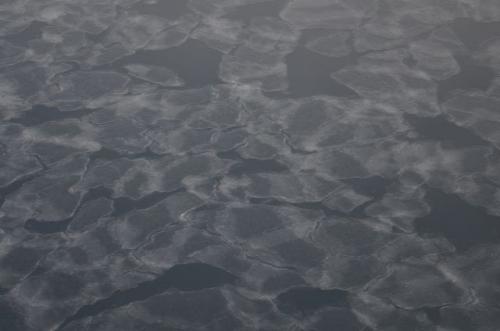
Sometimes the pieces are much larger and still overlap. This also happens with thicker ice as we will see below.
Slush You are probably familiar with slush even if yo do not live on a cold climate by the flavored 'slushies'. Slush is a viscous surface layer made by snow mixed with water. Here is a picture of a patch of slush as the trace metal rosette makes breaks the sea surface on its way down in the water column.
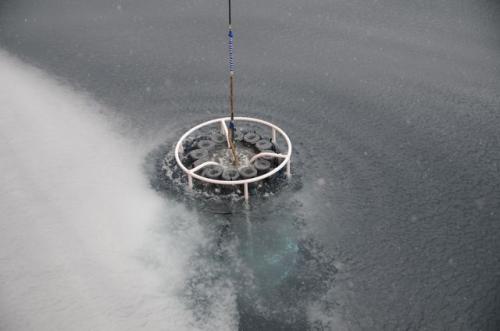
Young ice Once Nilas thickend above 10 cm ice becomes young ice. It is classified according to its thicknes into gray ice (10 - 15 cm or 4-6 in) and gray white ice (15-30 cm or 6-12 in). Young ice can also present rafting, as in the picture below where Gray ice with a dust of snow has created this nice pattern.
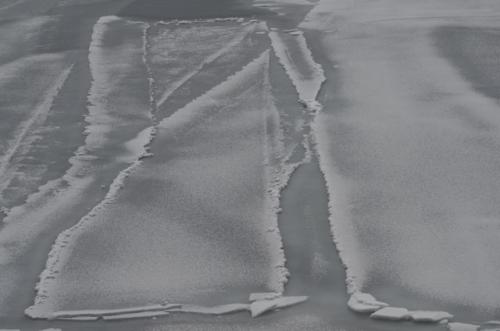
Sometimes both layers of young ice overlap each other creating what is called 'finger rafting' interlocking both layers. The fingers can be large (tens of centimeters) or very thin, a few centimeters.
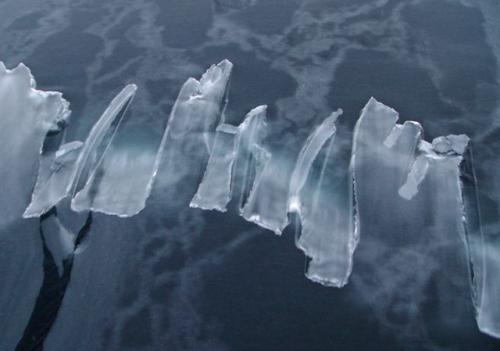
Pancake ice Pancake ice is formed from young ice when it is broken by the wave action into smaller pieces. The pieces develop rounded edges with a little crest from bumping into each other. We have crossed large fields of pancake ice of different sizes, from a few centimeters across (a couple of inches) to half a meter of more (about 2 feet), that look like tiled ocean. Here is the picture of a field of large pancake ice.
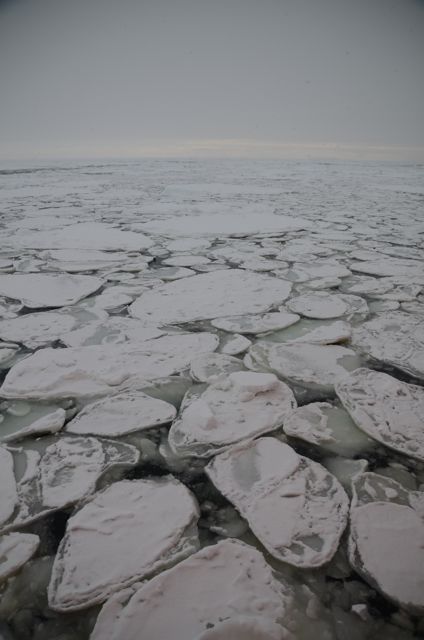
As calm conditions come back, the water between the pancakes freezes to produce a matrix of pancakes. This picture shows the small pancakes frozen together.
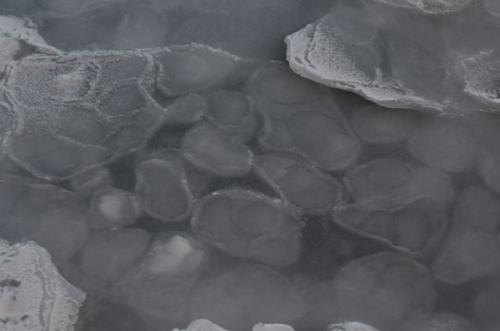
First year We finally arrive to the ice mentioned by Alex at the beginning of this entry. Eventually a uniform level area with no ridges develops that is 30 cm to 1.2 m thick (12 in - 4 ft). This is the first year ice. It is divided in thin, medium and thick, but that seems to technical for this journal. Here is a picture of us trying to move across 1 year ice.
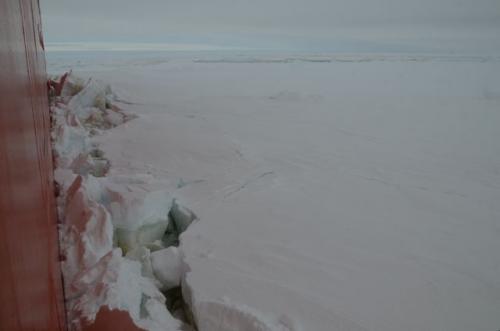
Multi-year ice Multi-year ice is ice that has survived at leas tone melting seasons. It is thicker than 3 m and usually shows weather ridges and well-defined melt water drainage. We landed on a multi-year ice platform when we arrived at McMurdo in what seems to be centuries ago.
We have seen a lot of times in which all these types of ice peacefully coexisting. In the following picture you can see rafting on the dark nilas, different stages of rafting in the young, gray ice pancakes towards the front, some pieces of gray-white young ice further back and multi-year pieces on the top right that are quite thick.
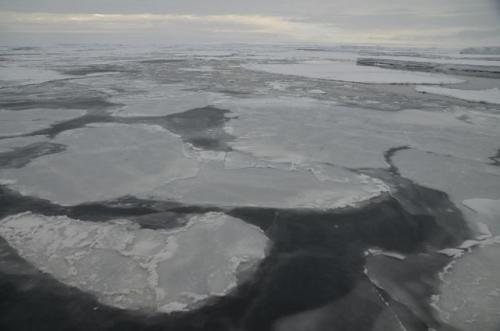
We are back on the ice, still far from our target location. Sailing is slow even though the ice is not very thick. Alex said it is 1st year ice with lots of snow, which produces a lot of the friction with the boat and slows it down. We have had to stop, back a bit, and then charge forward again. This is called ramming. I am not sure how much ramming we can do before turning back. The ice maps suggest there might be thinner ice ahead. Jim said we will see how far we get by breakfast, since we are running out of time.
First year ice, said Alex, what does he mean? This is a perfect time to talk about different types of ice. Perhaps you have heard that inuits have lots of words for naming snow. I have found people on board have quite a few words for naming ice according to its developmental stage. I will describe the basic terminology. I wish I could have gone out and place an object of known size so you would have a size reference. Let us take a look at some of these names:
The first stages of ice formation are the same as in a lake, so if you live in an area with cold winters near a like you might have seen these stages. Things get more interesting later as the waves modify the ice.
Frazil Frazil is the presence of ice crystals in the shape of fine needles or small flakes suspended in a somewhat thick layer of water.
I saw the second stage of ice formation for the first time at McMurdo Station on a very calm night. I looked out through the window of the library down to the bay and saw what appeared to be a thin skin on the water, undulating with the waves. I went down to see it more closely and found,
Grease ice Grease ice is a thin layer on the surface of the water that looks like oil or soap. The picture below shows grease ice in small patches separated by the wind. I took this picture from the bridge of the Palmer as we left McMurdo.

Nilas Nilas is formed under very calm conditions. The unperturbed grease ice thickens into a thin layer (less than 10 cm, 4 in) that bends with the waves. The waves can separate the nilas in smaller pieces. As the winds and waves move the nilas some of them would move above others, which creates very neat patterns. This process is called 'rafting'.

Sometimes the pieces are much larger and still overlap. This also happens with thicker ice as we will see below.
Slush You are probably familiar with slush even if yo do not live on a cold climate by the flavored 'slushies'. Slush is a viscous surface layer made by snow mixed with water. Here is a picture of a patch of slush as the trace metal rosette makes breaks the sea surface on its way down in the water column.

Young ice Once Nilas thickend above 10 cm ice becomes young ice. It is classified according to its thicknes into gray ice (10 - 15 cm or 4-6 in) and gray white ice (15-30 cm or 6-12 in). Young ice can also present rafting, as in the picture below where Gray ice with a dust of snow has created this nice pattern.

Sometimes both layers of young ice overlap each other creating what is called 'finger rafting' interlocking both layers. The fingers can be large (tens of centimeters) or very thin, a few centimeters.

Pancake ice Pancake ice is formed from young ice when it is broken by the wave action into smaller pieces. The pieces develop rounded edges with a little crest from bumping into each other. We have crossed large fields of pancake ice of different sizes, from a few centimeters across (a couple of inches) to half a meter of more (about 2 feet), that look like tiled ocean. Here is the picture of a field of large pancake ice.

As calm conditions come back, the water between the pancakes freezes to produce a matrix of pancakes. This picture shows the small pancakes frozen together.

First year We finally arrive to the ice mentioned by Alex at the beginning of this entry. Eventually a uniform level area with no ridges develops that is 30 cm to 1.2 m thick (12 in - 4 ft). This is the first year ice. It is divided in thin, medium and thick, but that seems to technical for this journal. Here is a picture of us trying to move across 1 year ice.

Multi-year ice Multi-year ice is ice that has survived at leas tone melting seasons. It is thicker than 3 m and usually shows weather ridges and well-defined melt water drainage. We landed on a multi-year ice platform when we arrived at McMurdo in what seems to be centuries ago.
We have seen a lot of times in which all these types of ice peacefully coexisting. In the following picture you can see rafting on the dark nilas, different stages of rafting in the young, gray ice pancakes towards the front, some pieces of gray-white young ice further back and multi-year pieces on the top right that are quite thick.



Comments